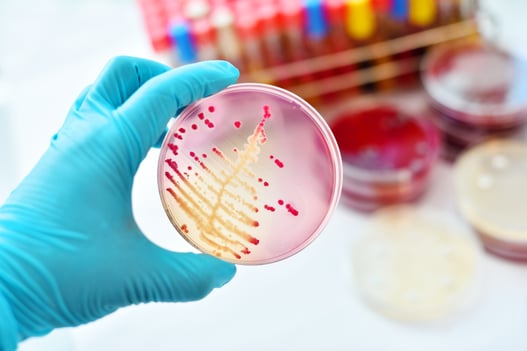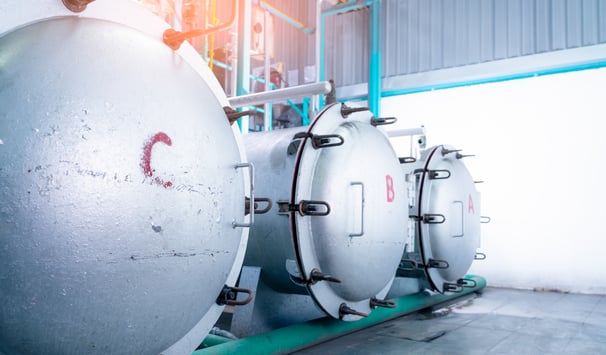Reviewed and Approved by Alex Brandt, Ph.D., Chief Science Officer, Food Safety Net Services
1 Minute Summary
- Alicyclobacillus are a genus of bacteria that can cause spoilage in apple juice, orange juice, white grape juice and other fruit juices.
- They are resilient to pasteurization and can grow in acidic environments, making them difficult to control.
- They can produce guaiacol, a compound that gives juices a medicinal or antiseptic flavor and that consumers can detect at levels as low as 2 ppb.
- There are two main methods for detecting Alicyclobacillus: PCR and traditional plating methods.
- In addition to testing, manufacturers should implement Good Manufacturing Practices (GMPs) and best practices for juice processing.
Alicyclobacillus is a genus of bacteria that presents a serious challenge for the beverage industry. While they are not pathogenic to humans, Alicyclobacillus spp. can create significant economic losses for fruit juice producers due to their ability to withstand the rigors of thermal processing, grow under acidic conditions, and create spoilage compounds that adversely affect the flavor and odor of beverages.
Although the first official report of fruit juice spoilage caused by Alicyclobacillus spp. was published in 1982, they have likely been causing spoilage problems since the beginning of the beverage industry. More recently, Alicyclobacillus spp. spoilage incidents involving different types of juices have occurred with alarming frequency. In fact, a survey of 57 companies revealed that 60% experienced spoilage events, of which 35% were caused by Alicyclobacillus spp.
Clearly, beverage manufacturers must understand these challenges so they can help prevent Alicyclobacillus spp. from ruining their products, wasting money, and damaging their brand.
In this blog post, we will cover some of the basics of Alicyclobacillus spp. biology along with some of the common methods used to detect it in food and beverage products.

The Remarkable Resilience of Alicyclobacillus
The genus Alicyclobacillus includes 18 species, but the species that are the most infamous in the beverage sector include…
- Alicyclobacillus acidoterrestris
- Alicyclobacillus acidocaldarius
- Alicyclobacillus acidiphilus
- Alicyclobacillus herbarius
This notoriety comes from their unique ability to withstand the hurdles to microbial survival and growth that are inherent to juice processing.
One characteristic that makes Alicyclobacillus spp. particularly resilient is their ability to form spores, which are survival structures that make them capable of surviving the typical pasteurization parameters of beverage production processes.
Moreover, they are acidophilic, which means they can grow within a pH range of 2.0 to 6.5 and flourish in low-pH environments typically associated with fruit juices, further complicating efforts to control their proliferation.
Additionally, their natural habitat is the soil, so fruits that come into contact with soil quickly become carriers of Alicyclobacillus spp. and serve as a source of entry into processing facilities.
What Products are Most Affected by Alicyclobacillus?
Apple juice and apple juice concentrates are the product most frequently contaminated with Alicyclobacillus. Studies on the topic often reference the prevalence of apple juice contamination.
Orange juice is another commonly affected product, as studies have shown.
However, many other juices can be affected, including tomato, pineapple, peach, white grape, pear, mango, and fruit juice blends.
The Negative Affects of Alicyclobacillus on Beverage Quality
The fallout from Alicyclobacillus spp. contamination in a beverage product is multifold. As we will discuss below, this contamination not only negatively impacts product quality, but also has a profound impact on the financial stability and reputation of manufacturers.
Tainting Flavor and Eroding Consumer Trust
One manifestation of Alicyclobacillus spp. spoilage is the significant alteration of a beverage's flavor.
Alicyclobacillus spp. produce guaiacol, a compound that imparts a distinctly “medicinal” or “antiseptic” flavor, effectively spoiling the original sensory profile of the beverage. In fact, consumers can detect guaiacol at concentrations as low as 2 ppb, meaning it's imperative to detect the presence of Alicyclobacillus in your products to safeguard your brand.
The Costly Consequences of Contamination
As noted above, one of the major challenges associated with Alicyclobacillus spp. is their ability to form spores that survive the temperatures typically used in pasteurization processes.
Because Alicyclobacillus spp. spores can withstand this heat treatment, they will remain viable in the product and can germinate when temperature conditions are more favorable to growth. Thus, contamination may only become apparent weeks or months later during the product's shelf-life. Shelf-life testing is an excellent way to monitor how your product reacts to its storage environment.
The resulting product spoilage can lead to substantial financial losses, stemming from the need to recall and replace the contaminated product and the ensuing damage to the brand.
Microbiology Testing: A Proactive Defense Against Alicyclobacillus
Considering the challenges posed by Alicyclobacillus spp., there is a need for proactive and robust microbiological testing within the beverage industry.
Fortunately, there are several methods that can help producers detect this organism in their raw materials and finished products.
Early Detection and Quantification of Alicyclobacillus
Microbiological testing acts as a critical defensive barrier against the destructive effect of bacteria like Alicyclobacillus spp. It enables the early detection and quantification of these bacteria, effectively identifying and managing potential microbial contamination sources, thereby diminishing the risk of product contamination.
There are two primary testing methods for Alicyclobacillus spp.
- Polymerase Chain Reaction (PCR)
- Traditional plating methods
Polymerase Chain Reaction Testing for Alicyclobacillus spp.
PCR is a state-of-the-art molecular technique that identifies and amplifies targeted DNA sequences in the bacterial genome, allowing for the rapid detection of Alicyclobacillus spp.
This method is particularly effective due to its speed, sensitivity, and specificity in detecting bacteria, even when they are present in very small quantities.
Traditional Plating Methods for Alicyclobacillus spp.
Traditional plating methods, on the other hand, are more time-consuming, but provide equally valuable insights.
These methods involve spreading the sample on a specialized growth medium (like K agar or BAT agar), followed by an incubation period at a specific temperature conducive for Alicyclobacillus spp. growth.
Post-incubation, the colonies that form are counted and analyzed to differentiate bacterial strains based on their colony morphology and biochemical properties. This helps quantify the amount of Alicyclobacillus spp. present and identify any potential risks of specific strains.
Alicyclobacillus in Fruit Juices: The Imperative of Regular Monitoring
Given the particularly high susceptibility of fruit juices to Alicyclobacillus spp. contamination, regular microbiological monitoring is essential for manufacturers. By incorporating rigorous and well-defined beverage testing protocols in your environmental monitoring program, manufacturers can ensure a consistent level of quality in their fruit juices, thereby effectively controlling the presence and potential spoilage consequences of Alicyclobacillus spp.
Specifically, for fruit juices, testing should be conducted at multiple stages in the production process, starting with the raw material and ending with the finished product.
Additionally, the processing equipment and production environment should be routinely tested to identify and subsequently eliminate any potential contamination sources. These comprehensive monitoring strategies help create a quality-controlled production process that is designed to mitigate Alicyclobacillus spp. and other microbial challenges.
Embracing a Holistic Approach: Quality Control Beyond Testing
While microbiological testing is crucial, it should be viewed as one component of a comprehensive quality control strategy designed to combat the threat of A. acidoterrestris effectively.
The Role of Good Manufacturing Practices (GMP)
In addition to rigorous testing, adhering to Good Manufacturing Practices (GMP) is vital to maintaining high product quality standards.
For beverage and juice manufacturing, GMPs encompass thorough cleaning and sanitation procedures for equipment, storage areas, and production surfaces. They also include the use of proper personal hygiene practices by employees and systematic checks on raw materials for quality assurance.
Implementing a rigorous GMP framework provides a strong foundation for beverage manufacturers to control the growth and proliferation of Alicyclobacillus spp., helping ensure the consistent production of high-quality beverages.
 Certain processing steps act as control points in your process to help mitigate Alicyclobacillus spp. in juices and other beverages.
Certain processing steps act as control points in your process to help mitigate Alicyclobacillus spp. in juices and other beverages.
Best Practices for Juice Processing to Mitigate Alicyclobacillus
While most juice processes have standard processing steps, there are still some best practices that can be implemented at each processing stage to enhance control of Alicyclobacillus spp.
In a juice manufacturing setup, some best practices that can be implemented include:
- Harvest and Receiving of Raw Materials: The initial quality of raw materials can significantly impact the final product's bacterial load. Avoiding harvest of fallen fruits (which could have contacted soil, where Alicyclobacillus are naturally found) and thorough cleaning of transport containers are key elements of mitigating Alicyclobacillus spp. at harvest. At receipt, removing excessively dirty fruit or fruit contaminated with extraneous matter, such as leaves, also helps in preserving raw material quality.
- Proper Storage Conditions: Implementing and maintaining appropriate storage conditions, including temperature and humidity, can inhibit the growth of Alicyclobacillus.
- Fruit Cleaning: Using chemical agents as part of the fruit washing and cleaning process helps reduce the load of Alicyclobacillus. Oxidizing agents such as aqueous chlorine, aqueous chlorine dioxide, and gaseous chlorine dioxide have all been shown to reduce contamination.
- Pressing and Juice Extraction: Ensuring good quality water is used as part of the juice extraction process is key for keeping Alicyclobacillus spores out of the process.
- Juice Clarification and Filtration: Ultrafiltration is widely used in the juice industry for clarification. However, filter integrity can become compromised when certain membrane material types are used and when the system becomes advanced in age. This can create small lesions or leaks that allow bacteria and spores to pass through. Thus, the integrity of the membrane should be checked regularly to maintain the effectiveness of this critical step.
- Pasteurization: One of the most significant control points, pasteurization, kills most bacteria present in the juice. However, since Alicyclobacillus form heat-resistant spores, standard pasteurization methods do not have a profound effect on reducing their presence. Thus, the use of alternative processing technologies such as high hydrostatic pressure (HHP, also abbreviated HPP for high pressure processing) or ultrasound in combination with the heat processes of pasteurization is an area currently being explored to see if reductions of Alicyclobacillus spp. can be enhanced by combining these hurdles. The concept behind this work is that the alternative technologies may help to weaken the spore structures in advance of pasteurization, which makes the thermal treatment more effective at reducing their viability.
- Filling Temperature and pH Control: Monitoring and controlling the filling temperature and pH levels in the finished product can also limit the growth of Alicyclobacillus.
- Equipment Sanitation: Since bacterial spores can reside on equipment surfaces and proliferate during the production process, regular and thorough cleaning of equipment is crucial.
The Importance of Staff Education and Regular Equipment Maintenance
Training staff on appropriate sanitation and hygiene practices can significantly reduce the risk of contamination.
Additionally, maintaining and sanitizing equipment regularly, coupled with strict quality checks of raw materials, can contribute significantly to an environment where problematic bacteria like Alicyclobacillus spp. are kept in check.
Tackling the challenge of Alicyclobacillus spp. demands a multi-faceted approach from beverage manufacturers, particularly those producing fruit juices. This approach should include…
- Rigorous microbiological testing.
- Diligent application of good manufacturing practices.
- Using best practices for juice production.
- Ongoing staff education.
- Regular equipment maintenance.
With such strategies in place, manufacturers can effectively manage the risks associated with Alicyclobacillus spp. ensuring the consistent delivery of high-quality beverages that consumers can enjoy without worry.
Certified Laboratories and Food Safety Net Services (FSNS), Certified Group Companies, can provide guidance for testing for Alicyclobacillus spp. in your production environment, raw materials, and finished products. Our experts can also validate your production process and perform a challenge study or shelf-life study to support your safety and quality programs. Reach out with questions and we’ll be glad to help

